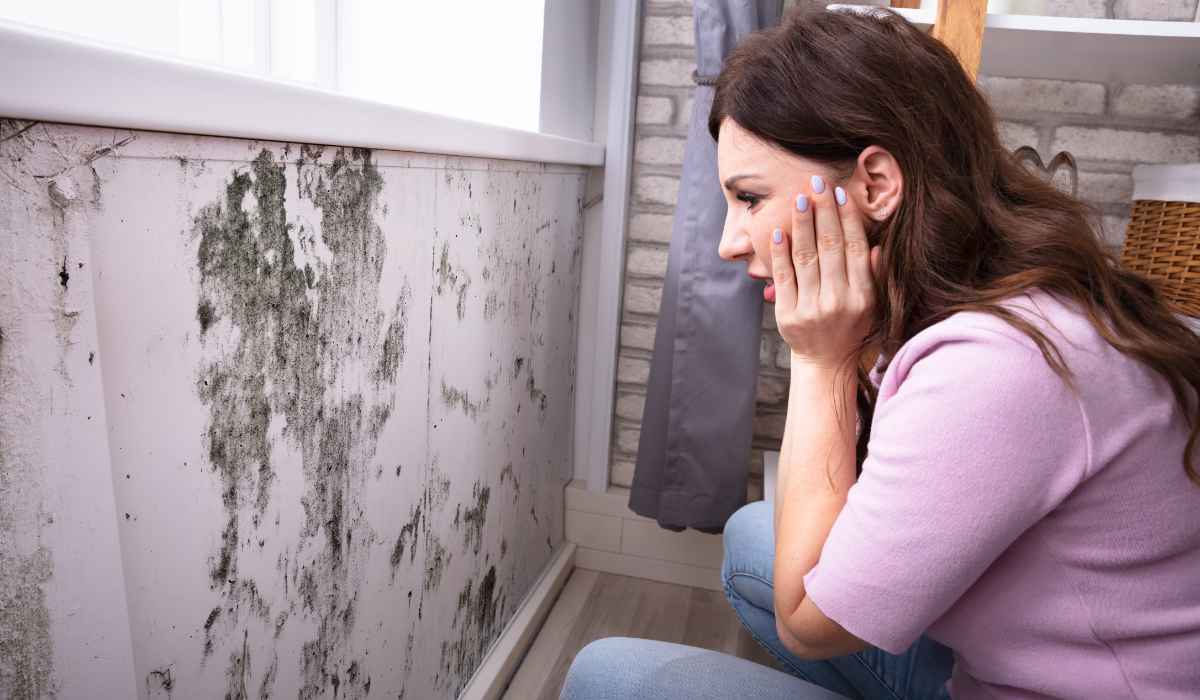Unsightly and unhealthy – mould, damp and condensation problems are surprisingly common in our homes.
While research by B&Q found a third (32%) of people in the UK have some form of mould, damp or condensation in their home, nearly two-thirds (62%) wouldn’t be able to tackle mould themselves, and one in 10 say they’d do nothing about it – or only deal with it if it got really bad.
“Many problems can arise when you leave mould untreated – not just to your home, but also to your health – so it’s really important people are aware of the risks,” says Susie Spence, B&Q’s director of interiors. Mould can cause respiratory problems and rashes – although B&Q found one in five people weren’t aware of the potential health implications.
Mould is most often caused by condensation. Indoor air quality and ventilation expert James Edwards, from ventilation company Nuaire, says: “People shouldn’t panic at a bit of condensation, but if it isn’t dealt with properly or quickly, it can lead to bigger problems such as black mould, and this shouldn’t be ignored.”
Edwards says it can penetrate walls and get into cavities, causing structural damage – and it can also lead to musty smells, staining, peeling wallpaper, cracked wall surfaces, plaster degradation, warped window frames and mildew on furniture and clothing.
“This can cost homeowners significant expense if not tackled in time,” he stresses. “But damage to the home is nothing compared to the health risks associated with condensation, damp and mould.
Shortness of breath is a symptom that is particularly severe in people who have asthma. Some studies even link exposure to mould to the development of this condition#Mould #MouldExposure pic.twitter.com/VeCHouxPm4
— Tempest Restoration (@tempestrestor) February 13, 2022
“Exposure to mould spores can also exacerbate eczema, and indoor dampness can promote bacterial growth and the survival of viruses.”
Here’s what you need to know about mould and condensation, and how to get rid of it…
1. The causes of mould
Mould can be caused by bad ventilation, not heating your home properly, poor insulation, humidity, and condensation. Condensation is the most common cause of mould, so the campaign stresses the importance of opening windows and heating your home appropriately.
View this post on Instagram
2. Know how condensation forms
Edwards says condensation occurs when warm, moist air meets cooler surfaces – for example, in a steamy bathroom with a cold windowsill. “This is particularly prevalent in winter as temperatures drop, windows get closed and households turn on their heating,” he explains. “The excess moisture in the air quickly condenses, and homes are at risk of condensation – experts call this the dew point.”
3. Water vapour settles on the coldest spots
We produce water vapour every day through routine activities, such as drying wet clothes inside, cooking, boiling the kettle, showering, bathing, and even talking and breathing, explains Edwards.
This leads to increased indoor humidity – and without adequate ventilation, moisture gets trapped. It migrates from wet rooms, settling on the coldest spots on ceilings, walls and near windows – often in the corners of a room, on an outside wall. “Once the warm, wet air has settled on a cold surface as condensation, it creates the perfect breeding ground for mould, which can be toxic,” he warns.
4. How to prevent condensation
“The best ways to permanently tackle condensation are by keeping a steady temperature throughout the property, keeping the air circulating and extracting excess humid air outdoors,” advises Edwards.
“Households can reduce levels of moisture in the home by drying clothes outside where possible, covering pans when cooking, shutting the bathroom door when showering or bathing, and ensuring extraction fans are switched on.”
5. How to get rid of mould

To get rid of mould, you’ll need a mask, goggles, gloves, protective clothing, and a floor covering, says TV homes and interiors expert Whinnie Williams. Spray a mould remover spray onto the affected area, leave it for 30 minutes, and then scrub and wipe the surface with a cloth.
“Once you’ve removed the mould, keep the surface well ventilated and let it dry,” Williams suggests. “And to prevent it coming back, paint the area with an anti-mould paint, or if you’re renting, ask your landlord to do this.”
6. How to prevent mould
Ventilation is crucial, says Williams, so open windows or buy a moisture absorber – drawing moisture out of the air. Mould likes damp, dark spaces, so check behind cupboards and drawers.
“It can appear inside cupboards and get into clothes and shoes, so be sure to check in the corners on the inside, too,” she advises. It’s also important to keep furniture at least two inches away from the walls, to provide space for ventilation.
7. And if you rent your home…
Mould problems in a rented home are often a landlord’s responsibility. Renters should check what’s causing the issue and talk to their landlord before doing any work themselves.
Best-selling dehumidifiers
Stuck for inspiration? Check out our list of best-selling Amazon products!
- DAMPNESS / HUMIDITY REMOVER: Ansio Interior Dehumidifiers are designed to remove dampness & humidity from the air. For domestic purposes only.
- EFFECTIVE IN REMOVING DAMPNESS: These disposable Dehumidifier tubs contain unique hydrophilic crystals that are specifically formulated to draw and retain moisture from the air. This helps combat...
- MOISTURE ABSORBERS: Designed to reduce mould, these dehumidifier tubs are ideal for rooms including kitchens, bathrooms, living rooms, bedrooms, basements, caravans, boats, garages or in any place...
- Moisture and odour control – The AERO 360° moisture absorber is a simple solution to effectively absorb excess moisture and neutralise bad smells in your home. It is ideal for rooms up to 20m²
- Optimal performance – The aerodynamic design promotes 360° air circulation for advanced efficiency. The tabs are made of active moisture absorbing crystals and include patented anti-odour agents
- Safe and silent – The AERO 360° humidity absorber device functions without electricity and provides maximum safety thanks to its spill-prevention system.
- 【Efficient Dehumidification】Our dehumidifiers 20L are able to remove up to 20L (under 95°F, 90%RH) of moisture per day and adjust humidity from 40% to 80%. This dehumidifiers for home damp is...
- 【Intelligent Humidity Sensor】This dehumidifiers with drain hose with digital display can provide convenient and accurate humidity readings. Set your desired humidity level, the dehumidifier for...
- 【Dry Clothes Mode & Auto Defrost】Dehumidifier for bathroom unique dry clothes mode allows you to dry clothes efficiently in wet and rainy days, which 20l dehumidifier with laundry mode can also...
- 【 COST OF LIVING ENERGY SAVING STAR 】Energy efficient dehumidifier has low power consumption low power consumption and optimised energy usage, costing less than 7p per hour (based on 34p/kWh)...
- 【 LAUNDRY DRYING MODE 】Not just a dehumidifier but also a clothes dryer with a dedicated laundry drying function this dehumidifier can be used in any area above 5°
- 【 EXTREMELY QUIET OPERATION 】This powerful dehumidifier efficiently removes moisture to protect walls, curtains, furniture and appliances from mould and damp at just 36dB at full speed. By keeping...
- EFFICIENT & ENERGY-SAVING: ELECCI quiet dehumidifier 10L can remove up to 10L per day (32°C, Rh80%), swiftly reducing indoor moisture and creating a comfortable living environment for you. In...
- VERSATILE & PRECISE: This dehumidifier with laundry mode excels in moisture removal and offers multiple functions, including a standard mode for precise humidity control (±5% RH). Rainy days and...
- USER-FRIENDLY DESIGN: Designed with user experience in mind, this dehumidifier for home offers a sleep mode with customizable 1-24 hour shutdown settings, ensuring it won't disrupt your rest. The...
- 【Advanced Dehumidifier for home】Removes moisture quickly and quietly with advanced semiconductor technology. 2200ml water tank for ample storage. Sleek design, easy-to-use controls, and healthy...
- 【Portable dehumidifier with colorful lights】Get a convenient and effective solution to your home's humidity problems with our versatile dehumidifier, which features 7 ever-changing lights for a...
- 【2 Working models】High speed mode with powerful speed for quickly and efficiently reduce the humidity. Night mode(sleep mode) with low speed operation, quietly working (
- 🌞【Upgraded Powerful Dehumidifiers】Still annoyed about the Wet Room, Moldy Clothes, Moisture closet, Damp Floor? Is it not environmentally friendly to use disposable dehumidifiers? The EasyAcc...
- 🌞【
- 🌞【Auto Shut off & Colorful Night Lights】 The visualized 40 OZ (1200ml) water tank is easy to take out, clean. This mini dehumidifier will auto shut down when the water tank reaches full, and...
Last update on 2024-03-31 / Affiliate links / Images from Amazon Product Advertising API
You may be interested in…
This article may include affiliate links to products and services where we may receive a small fee to support the running of this site if you make a purchase or is a sponsored article from one of our select editorial partners providing valuable advice and information to our readers.






































































